Seven Days: The Straight Dope From the Week That Was
by Geoff Kelly & Louis Ricciuti

Jerry Williams, tree-hugger:
Niagara Falls businessman and Lewiston Heights resident Jerry Williams turned a curious shade of green last week.
Williams called a meeting to discuss plans by the owner of the Whirlpool Jet Boat to invest $1 million in improvements to his launch, including a two-story, 2,700-square-foot new building, which Williams and others who oppose the expansion say will block views of the Niagara Gorge.
Williams also argues that the jet boats are causing erosion of the river’s banks, according to a report in the Niagara Gazette.
“Environmental disasters happen very slowly, that’s how they become disasters,” Williams said, according to the Gazette. “The [boat ride] makes a hundred trips every day. Four hundred waves a day slam into the shoreline, two hundred on each side. [Canada] hates it too, I’m not alone.”
Williams should know from slow-moving environmental disasters. He is a member of the partnership that purchased TAM Ceramics earlier this year. TAM’s predecessor, Titanium Alloys Manufacturing, recycled uranium and thorium metals, and later produced zirconium, which was used in military and industrial reactors, for the Manhattan Project, for the Atomic Energy Commission and for commercial use. The site has long been an environmental hazard—radium, thorium, and uranium were dumped in the back lot—and the company continues to be a polluter. The Williams family are also the former operators of the CECOS/BFI-Allied landfill on Pine Avenue, which was previously a Union Carbide dump where the company disposed of hazardous waste, including radioactive materials. Williams also restarted the SGL Carbon facility on Pine Avenue, another contaminated site, adjacent to the family’s old landfill. Another Williams family company, Ontario Specialty Contracting, famously dynamited the old Acheson Graphite building on Buffalo Avenue back in 2000—at night, without permits, laying a coat of asbestos and god-knows-what-else on the surrounding neighborhood.
Perhaps Williams shared his environmental road-to-Damascus moment with his Lewiston Heights neighbor, Sam Santarosa, president of Buffalo Fuel Corporation, a hazardous and nonhazardous waste transportation company. This week Santarosa’s company began the (permitted) demolition of the former National Carbon site on College Avenue in the Falls. That site is contaminated, too, and has historic significance: The graphite that Enrico Fermi used to create the world’s first sustained nuclear reaction was manufactured by National Carbon, a division of Union Carbide. The Department of Energy has recommended the preservation and interpretation of sites significant to the Manhattan Project, but National Carbon is rapidly becoming history: With the help of some federal subsidies, Santarosa is preparing the site for a company that harvests the raw materials from discarded automobile tires: carbon black, oil, steel, and syngas.
Replacing Kennedy:
This Saturday, Democratic Party committee members from the Erie County Legislature’s Second District will meet to endorse a candidate to succeed Tim Kennedy, who’s leaving the job to join the State Senate in January. The front-runner for the endorsement is Tim Whalen, who is supported by Kennedy’s sponsor, Congressman Brian Higgins. Another candidate is Brian Bollman, a legislative aide to Lovejoy Common Councilman Rich Fontana. In addition to Fontana’s, Bollman has the support of the South’s Mickey Kearns. That may not add up to enough committee votes for Bollman, but he says he’ll run for the office next fall with or without the party’s endorsement. “In my time working for Councilmember Fontana, I’ve built a strong base throughout the community,” Bollman says.
Canalside meetings continue:
Next Wednesday, December 15, the Campaign for Greater Buffalo History, Architecture & Culture will hold its annual holiday meeting at the Dnipro Ukrainian Hall (562 Genesee Street). There, executive director Tim Tielman will present the group’s proposals for waterfront development, which include extension of the Central Wharf to the foot of Main Street, the erection of a two-story public pavilion along the wharf, and construction of a pedestrian viaduct that will connect Canalside to the DL&W Terminal and the Cobblestone District.
The meeting is at 6:30pm.
Meantime, Mayor Byron Brown called a couple meetings of his own on the Canalside project this week. This first took place Tuesday evening at the Frank Merriweather Library on Jefferson Avenue. The audience was predominantly African-American, according to an AV correspondent who attended, which is a first: All previous public meetings on development of Buffalo’s Inner Harbor, whether called by community activists or elected officials or the state agency overseeing the project, have been mostly Caucasian affairs.
Brown opened the meeting by emphasizing the employment opportunities the project promised. Tom Dee, the executive director of the Erie Canal Harbor Development Corporation, talked at some length about the project’s history, potential attractions, and design goals.
Community activist and author Eva Doyle urged ECHDC to consider the rich African-American history of the project area. Incoming Ellicott District Councilman Darius Pridgen wondered whether waterfront development and in vestments in the Michigan Avenue Heritage Corridor could somehow be linked. A number of others in attendance offered examples of successful waterfronts in other cities—Baltimore, Chicago—and urged ECHDC to take lessons from those places.
But much of the talk focused on jobs and minority representation. Dee said ECHDC’s goal is to use 30 percent minority contractors, and tossed out the usual job creation numbers the agency uses to promote project: 500 construction jobs in the immediate future, and 50 to 100 permanent jobs; 3,000 construction jobs over the life of the project, and 1,000 permanent jobs. (Our correspondent says that Dee’s eyes widened when he talked about expanding the project to include the Outer Harbor, as has been proposed, saying all his numbers—jobs, public and private investment—would increase substantially.) Those numbers are often pure speculation, of course, as activist and journalist and ex-cop Ted Kirkland pointed out. The number of jobs promised by big public investments never reflects reality, Kirkland said, and the faces on the construction sites are always white. Thirty percent is too low a goal in a city whose population is about 45 percent minority, he said. Dr. Henry Louis Taylor of UB said ECHDC needed a committee to focus on minority representation.
Micaela Shapiro-Shellaby, representing the Canalside Community Alliance, argued for the implementation of a community benefits agreement, which would require companies receiving public funds on the project to pay a living wage, among other provisions. Mayor Brown dismissed the idea of a CBA, saying that that the Alliance’s proposals were silent on the issue of minority hiring goals. Shapiro-Shellaby agreed that they had been so far; she said that part of the CBA need to be settled in negotiations, which ECHDC has refused to engage.
Buffalo’s Common Council has made negotiation of such an agreement a condition for its release of city-owned land to ECHDC.

New reports on fracking:
Governor David Paterson has until Monday to decide whether he’ll sign a five-month moratorium on horizontal hydraulic fracturing for natural gas in New York State’s Marcellus Shale. Meantime, the online investigative journalism outfit ProPublica is reporting that expert testimony to be delivered next month the Delaware River Basin Commission will challenge the assumption that deep vertical drilling—which has been a common, legal practice in New York for decades—is safe. Two reports contend that vertical hydraulic fracturing and the drilling of exploratory wells yield their own environmental dangers. The reports focus on proposed wells in Pennsylvania, but the Delaware River Basin Commission is a federal agency with regulatory oversight in parts of Pennsylvania, New York, New Jersey, and Delaware.We’ll post the reports on AV Daily at Artvoice.com.
Tale of a sore loser, in three parts:
State Senator Antoine Thompson does not seem to be taking the loss of his seat well.
First, Thompson canceled his annual turkey giveaway the week before Thanksgiving, as the reports on the ballot review process in the 60th District race made it increasingly clear that he’d lost a squeaker to Democrat-turned Republican Mark Grisanti.
Then, when the tally was complete, Thompson issued something close to a concession but did not call Grisanti to congratulate him and wish him luck, as is the traditional practice.
Now, this week, Thompson has canceled his annual toy giveaway as well, according to an email sent to block clubs in the district.
A kinder, gentler Partnership:
The Buffalo Niagara Partnership released its annual wish-list of tax cuts and corporate subsidies a couple weeks back, and now the Partnership for the Public Good is preparing to announce its agenda for 2011. In keeping with PPG’s focus on creativity and community-building, the rollout takes place at a library instead of a bar, and includes music, dancing, and poetry, instead of carving stations and PowerPoints.
PPG’s agenda will include recommendations regarding the Erie County Holding Center, Canalside, Erie County cultural funding, and the Peace Bridge expansion project. The event takes place Monday, December 13, 2-4pm, in the Frank Merriweather Library, at the corner of Jefferson and East Utica.
Common Council report:
If you read this column early enough Thursday morning, and if you’re curious about how the city plans to spend the $22.4 million it intends to borrow for infrastructure improvement projects in 2011, get thee to City Hall at 10am. Buffalo’s Common Council will hold a special session Thursday morning (December 9) to discuss Mayor Byron Brown’s proposed 2011 capital budget. The meeting will take place in Council chambers. Among the topics likely to be discussed are these: What can the administration do about unspent capital improvement funds from previous years—not just from last year but from a decade ago? Will the South District’s Mickey Kearns insist on funding for a new roof for the Nevilly Court recreation and education complex in South Buffalo, which the mayor did not include in his proposed budget?
Tune in next week to find out.
—geoff kelly & louis ricciuti
blog comments powered by Disqus|
Issue Navigation> Issue Index > v9n49 (Winter Food Issue, week of Thursday December 9) > Week in Review > Seven Days: The Straight Dope From the Week That Was This Week's Issue • Artvoice Daily • Artvoice TV • Events Calendar • Classifieds |









 Current Issue
Current Issue